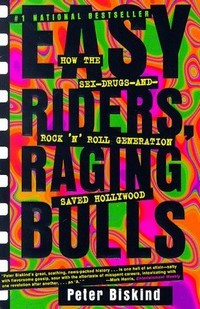I’m taking a film class on the New Hollywood era, 1960-1980. In the class we watch several iconic films of this era, while reading Peter Biskind's Easy Riders, Raging Bulls: How the Sex-Drugs-n-Rock & Roll Generation Saved Hollywood. The book follows the wild ride that was Hollywood in the ‘70s – an unabashed celebration of sex, drugs, and rock 'n’ roll (both onscreen and off) and a climate where innovation and experimentation reigned supreme. Based on hundreds of interviews with the directors themselves, producers, stars, agents, writers, studio executives, spouses, and ex-spouses, this is the full, candid story of Hollywood’s last golden age. I’d definitely recommend it, purchase it on Amazon.

The beginning of Biskind’s Easy Riders, Raging Bulls opens by suggesting that the new Hollywood era was “a cultural revolution. American style.” (14) The book goes on to name the who’s who of the various “waves” of New Hollywood directors who were “unembarrassed… to assume the mantle of the artist, nor did they shrink from developing personal styles…” (15). Coppola, Beatty, Hopper, & Nichols are followed closely in the first three chapters while the book details the production and release of Bonnie and Clyde and Easy Rider specifically.
Through these processes the reader is introduced to the unflattering behind-the-scenes of an otherwise glamorized era of filmmaking. Hopper’s anger and physical violence, the cursing, the drugs and drinking, and the “it’s not gonna happen” moments. Biskind writes, “in addition to bequeathing a body of landmark films, it has a lot to teach us about the way Hollywood is run now, why today’s pictures, with a few happy exceptions are so unbelievably awful, why Hollywood is in a perpetual state of crisis and self-loathing” (17). Even so, Biskind articulates well the attractive theory of “auteurism” and how this New Hollywood era “was a movement intended to cut film free of its evil twin, commerce, enabling it to fly high through the thin air of art” (17). From what I understood, all of this at the time was unstable, hazy, and without guarantee. It’s only now after looking back on the effect of the many films alluded to in the book, that the “cultural revolution” Biskind speaks of was intertwined tightly with New Hollywood films.
While it was easy for people of the prior era in film to regard films like Easy Rider or Bonnie & Clyde as amateur, disconnected, and technically-incorrect, Pauline Kael was the first to say “’You can look at this seriously, it doesn’t have to be an Antonioni film about alienated people walking on a beach in black and white for it to be a work of art” (41). This struck me as an important moment in the book, did the New Hollywood era make people watch films differently? When Time magazine put Bonnie and Clyde on the cover, the story was headlined “The New Cinema: Violence…Sex…Art” (45), suggesting that as Kael said, people can and should take this seriously.
In my opinion, that is because as I mentioned, the cultural revolution Biskind opens with is highly synonymous with the films coming out of the era. “If bond films legitimized government violence, and the Leone films legitimized vigilante violence, Bonnie and Clyde legitimized violence against the establishment, the same violence that seethed in the hearts and minds of hundreds of thousands of frustrated opponents of the Vietnam War… Bonnie and Clyde was a movement movie;” (49).
After watching Easy Rider, I can see moments of these same themes. Motifs like the American flag and the cross hint at establishment and authority, Southern racism and bigotry nods at the civil rights movement of the time, and long-haired hippies, communes, and psychedelics point to the flower-power counterculture that had emerged just prior to the films 1969 release. The technical production of the film inherently speaks to the Cultural Revolution as well. The drugs and alcohol consumed while shooting, the haphazard cuts, the technical imperfections such as lens flair that Hopper refused to take out, or even the idea that it was shot by a group of friends that had meetings while sitting cross-legged on the floor. It was the anti-establishment theme of the time, just as Biskind noted about Bonnie and Clyde that made it a ‘movement movie’.

proverse liked this
madisonglen-blog posted this